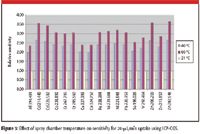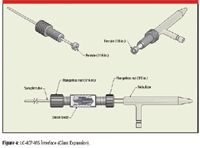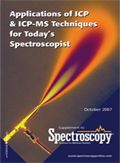Clinical Applications of ICP-MS: Optimizing the Front End
Special Issues
Two of the most significant areas of advancement in inductively coupled plasma-mass spectrometry (ICP-MS) with respect to clinical applications have been the evolution of the sample introduction system and the interface of liquid chromatography (LC). The complexity of the sample matrix creates challenges for a number of components involved with the introduction of ions into the mass spectrometer, including the nebulizer, spray chamber, torch, and interface cones. The development of LC-ICP-MS methods enables analysts to quantitate not only the total metal content but the form of the metal as well, a distinction that in many cases is crucial. Although the refinement of reaction and collision cell technology has been important for this application, much has been written elsewhere and it will not be addressed here.
The types of samples discussed here will be limited to blood (or blood serum), urine, and tissue. Each of these sample types has its own unique challenges. Blood samples have the advantage of being consistent yet very complex. Relatively high concentrations of iron, magnesium, calcium, sodium, potassium, copper, and zinc result in significant isobaric and mass–charge interference potential. Furthermore, the high organic content produces its own challenges. However, after a method has been developed to conquer or at least control these challenges, it usually is a robust method. On the other hand, urine samples vary widely in element and organic content. Though not as complex a matrix as blood, urine samples often present a more difficult challenge in the creation of a robust methodology. Tissue samples, because they are not in liquid form, pose the challenge of dissolution or digestion with the associated risk of contamination.
Due to sample volume limitations (particularly for infants and small animals), typical sample preparations must be scaled down to avoid large dilutions that would degrade detection limits unacceptably.
Sample Introduction System
A low sample uptake sample introduction system is recommended because of the limited sample available, the need for replicate measurements, and the expense of disposing of biological waste.
Nebulizer: The salient characteristics of a nebulizer used for clinical applications are the material of composition, the uptake rate, ruggedness, and consistency. Borosilicate glass, quartz, and perfluoroalkoxy (PFA) polymer are all well suited. Although quartz and PFA nebulizers might be preferred for applications requiring ultratrace determinations of certain elements including boron (such as those found in the semiconductor industry), glass nebulizers are adequately free of trace metals and, because of their lower cost, might be preferable for clinical applications. Concentric nebulizers provide the best performance but have a reputation for being easy to clog, which is particularly important for undigested biological samples. Concentric glass nebulizers that have a constant bore internal capillary reduce the likelihood of clogging (Figure 1). Depending upon the sample size available, uptake rates on the order of 0.1–0.4 mL/min are preferred. The mass transport to the torch of a 0.4-mL/min nebulizer is only slightly less than that of a higher uptake nebulizer because it generates a more efficient aerosol.

Figure 1: Concentric glass nebulizer with internal capillary made from a machined thick wall glass tubing (VitriCone, Glass Expansion).
Spray Chamber: This is a critical component of the sample introduction system, the significant characteristics of which are its composition, design, and temperature. Borosilicate glass provides adequate purity and a surface that is conducive to the smooth liquid sheeting action required for precise performance. A cyclonic design efficiently removes large droplets, while a central baffle acts as a droplet-size cutoff filter, resulting in a fine and consistent tertiary aerosol, thereby enhancing ion production in the plasma. Temperature control of the spray chamber is important in several respects. Setting the spray chamber at close to 0 °C reduces the water transport to the plasma, causing a commensurate reduction in potentially interfering oxides (Figure 2). Moreover, stabilizing the chamber temperature produces a more uniform response over the long term. For those samples with extremely limited volumes requiring uptake rates of less than 0.1 mL/min, elevating the temperature of the spray chamber is a good way to increase sample transport to optimize detection limits. Figure 3 shows the effect of spray chamber temperature on sensitivity for a 20-μL/min sample uptake rate. Data shown in Figures 2 and 3 were generated with a programmable temperature spray chamber (IsoMist, Glass Expansion, Pocasset, Massachusetts), which can be employed with virtually all commercially available ICP-optical emission spectroscopy (OES) and ICP-MS systems and covers the range of -10 °C to 60 °C.

Figure 2: Effect of spray chamber temperature on oxide ratio (1).
Torch: The most important torch characteristic for this application is the design of the injector tube. To tolerate complex samples without a buildup, either a capillary bore (no internal taper at all) or a gradual taper is recommended. Also, a larger bore decreases the likelihood of interfering deposits. Although injectors are available in a variety of materials, including alumina, sapphire, and platinum, quartz is sufficiently pure and tolerant of the samples encountered in this application.

Figure 3: Effect of spray chamber temperature on sensitivity for 20-μL/min uptake using ICP-OES.
Sampler and Skimmer Cones: Both the material of composition and the orifice size are important considerations. For a few reasons, platinum cones might be preferable to nickel for this application. First, if nickel is of analytical significance, platinum offers an obvious advantage. Second, as compared to nickel, the more noble platinum reduces the degree of salt pitting of the cone, thereby extending its useful life. Also, platinum cones run hotter than nickel, reducing carbon buildup within the orifice. A slightly larger orifice in the sampler cone than that recommended for cleaner samples also helps to reduce residue buildup in the orifice.
Other Considerations
Nebulizer maintenance: To prevent protein or salt deposits at the tip of the nebulizer, the nebulizer should be removed at the end of each day and back flushed with methanol. Nebulizer cleaning tools are available to facilitate this task.
Internal standardization: Rather than pipetting an internal standard "soup" into each sample standard and blank separately, it might be more efficient to use an in-line additions kit instead.
Nebulizer to spray chamber interface: Many spray chambers use O-rings to seal the nebulizer in the chamber port. For clinical samples, this interface provides a location for buildup of protein, which can degrade precision. Spray chambers are available with O-ring-free nebulizer fittings, which eliminate this risk.
Helium as auxiliary gas: Adding helium gas to the argon flow has been shown to result in fewer argon oxide interferences and greater ion production, particularly for difficult-to-ionize elements such as arsenic, selenium, and lead (2). Either the spray chamber or the torch adaptor can be configured with a port to accommodate the addition of an auxiliary gas.
LC-ICP-MS
The interfacing of an LC system to the ICP-MS system requires certain modifications to the sample introduction system. The nebulizer natural uptake rate should be matched to the eluent rate of the LC system to maintain laminar flow. In addition, the interface of the LC eluent line to the nebulizer must be as short as possible with minimum dead volume and be capable of withstanding high pressures (Figure 4). In addition, the spray chamber volume should be minimized to limit peak broadening. Although 20-mL internal volume spray chambers are available, even smaller volume chambers might result in sharper peaks, and experimentation is ongoing in this regard.

Figure 4: LCâICP-MS interface (Glass Expansion).
Jerry Dulude is with Glass Expansion, Inc., Pocasset, Massachusetts.
References
(1) Data courtesy of David Jones of ALS Chemex, Brisbane, Australia, taken on a PE Sciex Elan 6000 using an IsoMist programmable temperature spray chamber.
(2) B.S. Sheppard, W.L. Shen, T.M. Davidson, and J.A. Caruso, J. Anal. At. Spectrom. 5, 697–700 (1990).

High-Speed Laser MS for Precise, Prep-Free Environmental Particle Tracking
April 21st 2025Scientists at Oak Ridge National Laboratory have demonstrated that a fast, laser-based mass spectrometry method—LA-ICP-TOF-MS—can accurately detect and identify airborne environmental particles, including toxic metal particles like ruthenium, without the need for complex sample preparation. The work offers a breakthrough in rapid, high-resolution analysis of environmental pollutants.
Trending on Spectroscopy: The Top Content of 2024
December 30th 2024In 2024, we launched multiple content series, covered major conferences, presented two awards, and continued our monthly Analytically Speaking episodes. Below, you'll find a selection of the most popular content from Spectroscopy over the past year.